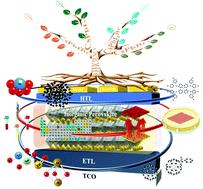Our official English website, www.x-mol.net, welcomes your
feedback! (Note: you will need to create a separate account there.)
Challenges and strategies relating to device function layers and their integration toward high-performance inorganic perovskite solar cells.
Nanoscale ( IF 5.8 ) Pub Date : 2020-06-15 , DOI: 10.1039/d0nr03408h Huaxin Wang 1 , Haiyun Li , Wensi Cai , Pengfei Zhang , Siliang Cao , Zhenyu Chen , Zhigang Zang
Nanoscale ( IF 5.8 ) Pub Date : 2020-06-15 , DOI: 10.1039/d0nr03408h Huaxin Wang 1 , Haiyun Li , Wensi Cai , Pengfei Zhang , Siliang Cao , Zhenyu Chen , Zhigang Zang
Affiliation

|
Parallel to the flourishing of inorganic–organic hybrid perovskite solar cells (PSCs), the development of inorganic cesium-based metal halide PSCs (CsPbX3) is accelerating, with power conversion efficiency (PCE) values of over 20% being obtained. Although CsPbX3 possesses numerous merits, such as superior thermal stability and great potential for use in tandem solar cells, severe challenges remain, such as its phase instability, trap state density, and absorption range limitations, hindering further performance improvements and commercialization. This review summarizes challenges and strategies relating to each device functional layer and their integration for the purposes of performance improvement and commercialization, utilizing the fundamental configuration of a perovskite photo-absorption layer, electron transport layer (ETL), and hole transport layer (HTL ). In detail, we first analyze comprehensively strategies for designing high-quality CsPbX3 perovskite films, including precursor engineering, element doping, and post-treatment, followed by discussing the precise control of the CsPbX3 film fabrication process. Then, we introduce and analyze the carrier dynamics and interfacial modifications of inorganic ETLs, such as TiO2, SnO2, ZnO, and other typical organic ETLs with p-i-n configuration. The pros and cons of inorganic and organic HTLs are then discussed from the viewpoints of stability and band structure. Subsequently, promising candidates, i.e., HTL-free carbon-electrode-based inorganic CsPbX3 PSCs, that meet the “golden triangle” criteria used by the PSC community are reviewed, followed by discussion of other obstacles, such as hysteresis and large-scale fabrication, that lie on the road toward PSC commercialization. Finally, some perspectives relating to solutions to development bottlenecks are proposed, with the attempt to gain insight into CsPbX3 PSCs and inspire future research prospects.
中文翻译:

与器件功能层及其与高性能无机钙钛矿太阳能电池集成相关的挑战和策略。
与无机-有机混合钙钛矿太阳能电池(PSC)蓬勃发展同时,无机铯基金属卤化物PSC(CsPbX 3)的发展也在加速,功率转换效率(PCE)值已超过20%。虽然CsPbX 3具有许多优点,例如优异的热稳定性和在串联太阳能电池中使用的巨大潜力,仍然存在严峻的挑战,例如其相不稳定,陷阱态密度和吸收范围限制,从而阻碍了进一步的性能改进和商业化。本文综述了钙钛矿光吸收层,电子传输层(ETL)和空穴传输层(HTL)的基本配置,以提高性能和实现商品化,涉及与每个器件功能层及其集成相关的挑战和策略。 。详细地说,我们首先全面分析设计高质量CsPbX 3的策略。钙钛矿膜,包括前体工程,元素掺杂和后处理,然后讨论CsPbX 3膜制造工艺的精确控制。然后,我们介绍并分析了无机ETL(如TiO 2,SnO 2,ZnO以及其他典型的具有引脚配置的有机ETL)的载流子动力学和界面修饰。然后从稳定性和能带结构的角度讨论了无机和有机HTL的优缺点。随后,有希望的候选物,即无HTL的碳电极基无机CsPbX 3审查了满足PSC社区使用的“金三角”标准的PSC,然后讨论了PSC商业化道路上的其他障碍,例如磁滞和大规模制造。最后,提出了与开发瓶颈解决方案有关的一些观点,以试图深入了解CsPbX 3 PSC,并激发未来的研究前景。
更新日期:2020-07-16
中文翻译:

与器件功能层及其与高性能无机钙钛矿太阳能电池集成相关的挑战和策略。
与无机-有机混合钙钛矿太阳能电池(PSC)蓬勃发展同时,无机铯基金属卤化物PSC(CsPbX 3)的发展也在加速,功率转换效率(PCE)值已超过20%。虽然CsPbX 3具有许多优点,例如优异的热稳定性和在串联太阳能电池中使用的巨大潜力,仍然存在严峻的挑战,例如其相不稳定,陷阱态密度和吸收范围限制,从而阻碍了进一步的性能改进和商业化。本文综述了钙钛矿光吸收层,电子传输层(ETL)和空穴传输层(HTL)的基本配置,以提高性能和实现商品化,涉及与每个器件功能层及其集成相关的挑战和策略。 。详细地说,我们首先全面分析设计高质量CsPbX 3的策略。钙钛矿膜,包括前体工程,元素掺杂和后处理,然后讨论CsPbX 3膜制造工艺的精确控制。然后,我们介绍并分析了无机ETL(如TiO 2,SnO 2,ZnO以及其他典型的具有引脚配置的有机ETL)的载流子动力学和界面修饰。然后从稳定性和能带结构的角度讨论了无机和有机HTL的优缺点。随后,有希望的候选物,即无HTL的碳电极基无机CsPbX 3审查了满足PSC社区使用的“金三角”标准的PSC,然后讨论了PSC商业化道路上的其他障碍,例如磁滞和大规模制造。最后,提出了与开发瓶颈解决方案有关的一些观点,以试图深入了解CsPbX 3 PSC,并激发未来的研究前景。











































 京公网安备 11010802027423号
京公网安备 11010802027423号